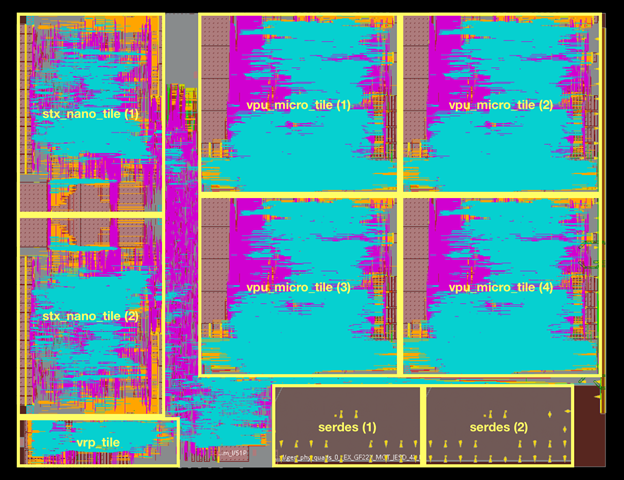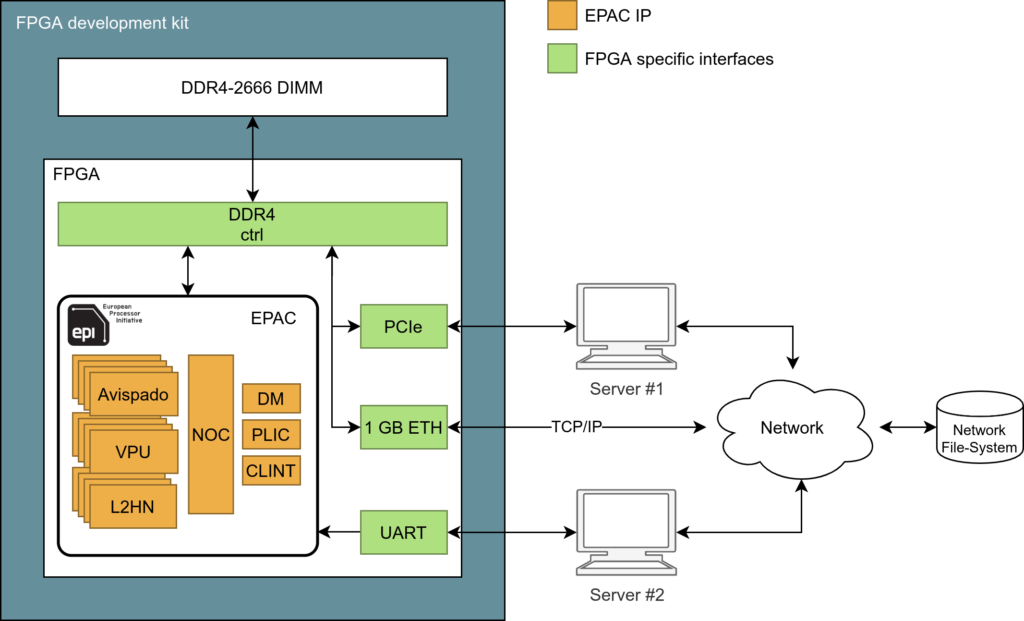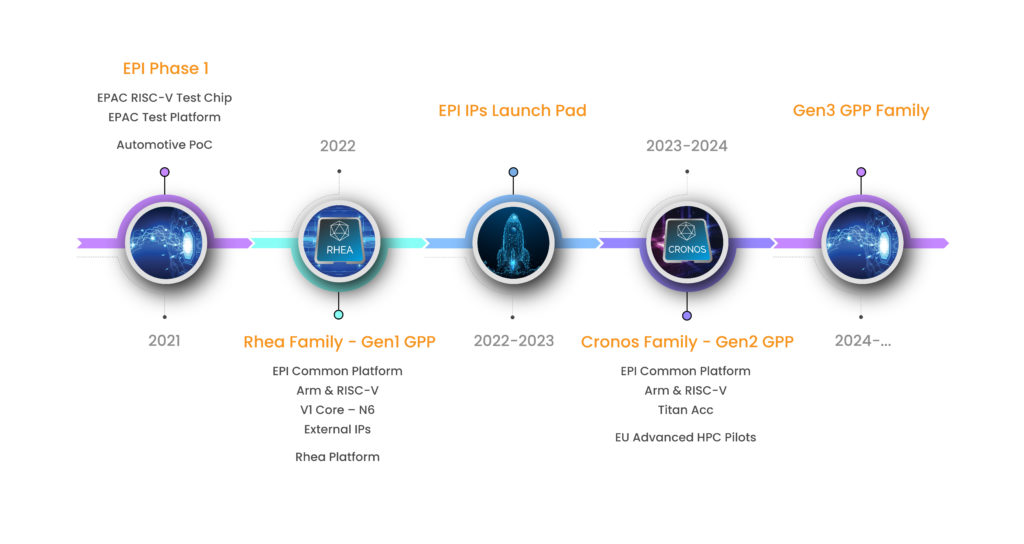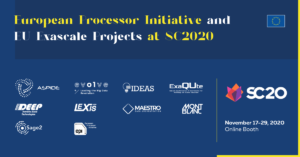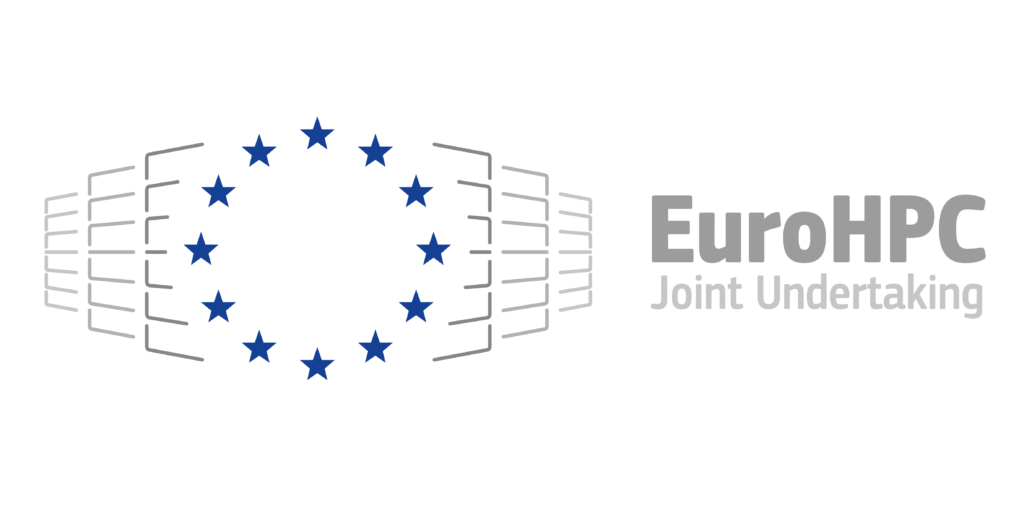EuroHPC Summit 24, a conference gathering European key stakeholders and users in the high-performance computing field, was held from March 18 to March 21, 2024, in Antwerp, Belgium.
The conference gathered more attendees than ever before, who were eager to see that is new in the European HPC space and perhaps eager to visit poster sessions, demos or finally, get a special look into the work of European supercomputers.
The European Processor Initiative was present at the event. Our CCO, Mario Kovač, attended the poster sessions explaining how far along we are in the project timeline.
Colleagues from Barcelona Supercomputing Centre showcased the EPAC chip, the first RISC-V based prototype leveraging vector acceleration coming from the EPI project.
EPI’s General Manager, Etienne Walter, and SiPearl’s CEO and founder, Philippe Notton, attended the parallel sessions on European Chip Initiatives for HPC, where they gave a detailed overview of what EPI is doing right now and what kind of developments can be underway for Rhea1 and Rhea2 processors.
On July 19th, the Council Regulation establishing the European High-Performance Computing Joint Undertaking was published in the Official Journal of the European Union. It was formally adopted on July 13th, by the Economic and Financial Affairs Council.
This is an important piece of news for the HPC community, opening up EuroHPC JU’s ability to draw funds from the Horizon Europe, Digital Europe and the Connecting Europe Facility programmes. The news item and full regulation text can be found on the EuroHPC JU’s website, here:
Taking place on 30 August – 3 September 2021, the second ACM Europe Summer School on HPC Computer Architectures for AI and Dedicated Applications will be co-hosted by Barcelona Supercomputing Center (BSC), in conjunction with the Universitat Politècnica de Catalunya – Barcelona Tech (UPC).
The programme of this year’s summer school, which will be fully remote, centres around topics within the European Processor Initiative. Open hardware expert Luca Benini (ETH Zürich / University of Bologna) will be discussing machine learning from a RISC-V platform perspective, while the EPI Accelerator stream leader Jesús Labarta (BSC) will train attendees in performance analysis and hybrid programming, helping them get the very best out of their code. Meanwhile, Mauro Olivieri (Sapienza – University of Rome / BSC) will present vector acceleration in high-performance computing (HPC) and edge devices.
Keynote talks will be given by celebrated computer scientists and engineers including Luca Cardelli (Oxford University), Bill Dally (Stanford University / NVIDIA), Mihaela van der Schaar (Cambridge University) and Mateo Valero (BSC). There will also be invited talks by EPI researchers Roger Espasa (Semidynamics) on the RISC-V Avispado core, John Davis (BSC) on building an open-source ecosystem for HPC, and Marc Casas (BSC) on accelerating deep neural network training.
The school chairpersons are Mateo Valero and Josep Fernandez (UPC), while the local organizing committee is led by Eduard Ayguadé, (BSC and UPC), and Fabrizio Gagliardi (BSC and ACM).
“EPI is revolutionising computer architecture to pave the way for Europe’s technological sovereignty. As part of the EPI training programme, this summer school provides the ideal introduction to some of the initiative’s main themes,” commented Jean-Marc Denis (Atos / SiPearl), chairman of the EPI board.
Upon completion of the school, all attendees will receive a certificate and a complimentary ACM student membership. Based on the scores obtained in the practical exercises, the best performing students will receive a certificate of honour and will also invited to interviews with industry sponsors, with a view to a possible internship.
The school includes a poster session, with a prize for the best poster.
Registration will be open until 15 July, and accepted candidates will be informed by 1 August.
To register, complete the registration form on the ACM Europe website.
The Initiative has successfully released EPAC1.0 Test Chip for fabrication
The European Processor Initiative (EPI) https://www.european-processor-initiative.eu/, a project with 28 partners from 10 European countries, with the goal of helping the EU achieve independence in HPC chip technologies and HPC infrastructure, is proud to announce that we have successfully released our EPAC1.0 Test Chip for fabrication.
One key segment of EPI activities is to develop and demonstrate fully European-grown processor IPs based on the RISC-V Instruction Set Architecture, providing power-efficient and high-throughput accelerator cores named EPAC (European Processor Accelerators). Using the RISC-V Instruction Set Architecture will allow leveraging open-source resources at hardware architecture and software level, as well as ensure independence from non-European patented computing technologies.
EPAC combines several accelerator technologies specialized for different application areas. The test chip, shown in figure 1 below, contains four vector processing micro-tiles (VPU) composed of an Avispado RISC-V core designed by SemiDynamics and a vector processing unit designed by Barcelona Supercomputing Center and the University of Zagreb. Each tile also contains a Home Node and L2 cache, designed respectively by Chalmers and FORTH, that provide a coherent view of the memory subsystem. The Stencil and Tensor accelerator (STX) was designed by Fraunhofer IIS, ITWM and ETH Zürich, and the variable precision processor (VRP) by CEA LIST. These specialized accelerators are connected with very high-speed network on chip and SERDES technology from EXTOLL.
The EPAC design was finalized by Fraunhofer IIS for chip integration in GLOBALFOUNDRIES 22FDX low-power technology and will be integrated and evaluated in the FPGA-based board designed by FORTH, E4 and the University of Zagreb. The successful fabrication of EPAC will showcase the next step in accelerator-based green HPC computing.
The outlook
The next generation of the EPAC accelerators and interfaces will be improved and refined for even higher performance and lower power levels in 12 nm technologies and below, and by adding a chiplet approach.
Jesus Labarta, BSC (EPAC Coordinator): I am really happy how partners with different backgrounds and motivations have been able to collaboratively develop this chip, putting all their efforts towards a collective success. It is a fully European design, driven by a vision of throughput-oriented computing and featuring characteristic that will result in high programmer productivity and achieve very high performance at low power and cost. Although just an initial Test Chip, it can be a significant step forward in HPC but also for edge and embedded applications.
Norbert Schuhmann, Fraunhofer IIS: The key challenge in this design and architecture was not only to achieve highest throughput and low power levels within the accelerators running on more than 1 GHz, but also to be in sync like in a concerto with memory accesses and data transport inside the chip and to the peripherals at rates above 200 Gbit/s.
Knut Hufeld, Senior Director R&D with Infineon and an Automotive Stream representative in EPI, talked about the developments in the stream with journalist Ralf Hartmann.
Infineon is known for microcontroller embedded real-time applications, so the European Processor Initiative EPI seems to be an ideal research field?
Definitely yes! With electric and autonomous driving as one of our main future issues, there will be an ever-increasing demand for computing power. Sophisticated driver assistance systems are one thing but new and highly complex applications like environment recognition in real-time will be another. Individual applications may be demanding, but operations like the fusion of sensor data from cameras, radar, or lidar systems are a real challenge. Conventional automotive microcontrollers are not capable to process the mass of information.
How could you bridge this impending gap in computing power?
One approach would be to take reliable automotive microprocessors like Infineon’s AURIX™ which are functional safe up to ASIL-D, and for the algorithms with an intense computing effort you just add processors from the consumer sector to be integrated with little or no adjustment or modification. This way, you create a safety/security configuration with the automotive-qualified real-time microprocessor controlling and monitoring the number crunchers from the consumer world.
Sounds like a makeshift constellation.
Indeed, using consumer parts is nothing but a work-around solution. First, because neither functional safety nor long-term reliability are ensured; second, they are not designed to the system, and moreover, they tend to use way too much energy.
What is the approach in EPI?
Regarding high-performance computing, HPC, the approach is to build a general-purpose processor, a GPP, which is designed for both high-level computing power and low-level energy consumption alike. This is where downsizing comes into play, which means that the number of computation kernels is reduced to what is necessary for automotive. We are talking about a derived variant of the GPP capable to serve typical automotive requirements on a minimum level and hence close the gap.
With its expertise in Automotive and as leader of Stream4 in EPI, which aspects does Infineon have to consider?
In the end, any technical achievement should be economically viable. Considering the high development costs, the challenge is to create downsized variants derived from HPC processors suitable for embedded constellations like in Automotive. Once they meet a high enough demand, they can be produced in sufficiently high unit numbers. The good news, recent developments indicate that the market will move in that direction, soon.
So, you bet on a win-win situation for HPC technology and the embedded sector?
As I said, the prospects are good. With a high demand for downsized variants and their mass production in the embedded sector, HPC can benefit from overall profitability generated by automotive as the driving belt. With this obvious solution, the high investments will pay off and HPC has a chance to become self-sustainable.
…which seems to be the key aspect in Stream4 as the mere automotive part in EPI?
That’s exactly it. Infineon coordinates the automotive part with partners like BMW, Elektrobit, Menta or Kalray, but also academic partners like Karlsruhe Institute of Technology, the Universities of Pisa and of Zagreb and Barcelona Supercomputing Centre. Our achievement is the implementation of a prototype automotive compute platform with integrated accelerators and other main IP blocks. Now, we are waiting for EPI partner SiPearl to come up with its first generation of HPC general-purpose processors. Then we can integrate and test them.
What will be your role in EPI’s upcoming evolutions?
We will still be present, albeit in a different way. In the first round, the Stream4 automotive team managed to accomplish promising results implementing the eHPC automotive platform, which reassures our pursued direction of development. In the upcoming round, we will adapt Infineon’s role towards an Industrial Advisor for embedded computing as an associated partner. This way, the EPI Initiative can take a full share of the limited financial funding resources for HPC technology, while we can shift our focus to setting up complementary projects under the European initiative KDT JU which then may give the opportunity for further synergies within EPI. In the meantime, we will, of course, meet our contractual obligations like exploiting the achievements of EPI. Regarding an effective promotion through face-to-face meetings, we hope that the current restrictions due to the COVID-19 pandemic will soon be lifted.
The European Processor Initiative (EPI) https://www.european-processor-initiative.eu/, a project with 28 partners from 10 European countries, with the goal of helping the EU achieve independence in HPC technologies is proud to announce that we have successfully booted Linux on our EPAC 1.0 core subset implemented on FPGA.
One key segment of EPI activities is to develop and demonstrate fully European processor IPs based on the RISC-V Instruction Set Architecture, providing power efficient and high throughput accelerator core named EPAC (European Processor Accelerator). Using RISC-V will allow leveraging open-source resources at hardware architecture level and software level, as well as ensuring independence from non-European patented computing technologies.
First silicon implementation of EPAC 1.0 test chip is expected in the second half of 2021 and as an important technical milestone towards that goal, we have successfully booted Linux on a subset of EPAC 1.0 synthesized on FPGA. The FPGA design includes the Avispado RISC-V core, the Vector Processing Unit (VPU), the Network on Chip (NoC), the Shared L2 Cache with Coherence Home Node (L2HN), interrupt controllers, IO peripherals and several other components. This implementation will enormously speed-up software development on the EPI HPC architecture as well as testing and improving the architecture for next generations EPAC chips.
For the development of the EPI Accelerator Test Chip, we make extensive use of FPGA technologies to verify the RTL design of the Test Chip. The subset of EPAC 1.0 emulated on FPGA we use as Software Development Vehicle (SDV) to enable early software development before the actual Test Chip silicon comes back from the foundry.
The use of FPGAs enables the testing of RTL blocks with real and very complex software in timescales that are not tractable using pure RTL simulation. Also, it allowed us to stress memory coherence and several related corner cases. We have managed to boot Linux using the EPAC 1.0 system on FPGA and the system boots within a few dozens of seconds compared to weeks using pure simulation. The system is fully usable and interactive for system software and application development and it also includes Ethernet connectivity to enable running large and complex software packages, e.g., OpenMP, MPI.
This is a serious proof of concept that gives us the confidence of a functional and viable future product.
More details on the results can also be found on EPI YouTube Channel, where you can find the second episode of EPI Talks podcast, themed with booting Linux:
Channel: https://www.youtube.com/c/EuropeanProcessorInitiative/featured
Video: https://www.youtube.com/watch?v=X4klPnBjstI
This year’s HiPEAC conference was supposed to be held in beautiful Budapest, from January 18th to 20th 2021. However, due to the persistent pandemic conditions, it had to be moved to a digital edition.
European Processor Initiative’s consortium gladly accepted the opportunity to participate, both as a sponsor and with a tutorial given to the attendees. Our tutorial was held on Monday, January 18th, and it involved the following topics and presenters:
- Denis Dutoit, CEA: EPI overview and introduction to tutorial topics
- Sergio Saponara, UNIPI: Hardware security module in the EPI GPP
- Fabrizio Magugliani, E4: Update of the PCIe boards as development testbed for EPI
- Lilia Zaourar, Tanguy Sassolas, CEA: SESAM/VPSim: fast and highly configurable simulation framework for the EPI processor
- Andrea Bartolini, Giovanni Bambini, UNIBO: Emulating the power controller of the HPC power management systems
The tutorial was very well attended, and the attendees had a lot of interesting questions.
In addition to the tutorial, the EPI team has also hosted a virtual Brazen booth, where students, young researchers, and other prospective employees popped in to ask questions about the project. From the industrial side of EPI, Fabrizio Magugliani presented EPI in the industrial session, while Jurgen Becker attended the WRC workshop and gave an invited talk that involved EPI as well.
All of the presentations from HiPEAC given by EPI members can be found in our repository:
https://www.european-processor-initiative.eu/dissemination-material/epi-at-hipeac-2021/, while the tutorial video is also available on our YouTube Channel: https://www.youtube.com/watch?v=4AYDc6THtcM&t=9476s.
Finally, a shout-out to organizers: even though the team is more than eager to participate in the next one, hopefully live, HiPEAC conference, we are thankful to organizers for such a wonderful experience and the opportunity to share our views and ideas.
The European Processor Initiative, a project with 27 partners from 10 European countries, with the goal of helping the EU achieve independence in HPC technologies, is finishing its second year of activities.
Despite 2020 bringing upon our young efforts the circumstances that were previously unimaginable, causing the subsequent cancellation of the first-ever planned European Processor Initiative Forum, the partners in the Initiative managed to stay the course and maintain all activities in all designated streams.
The year began with our latest partner, SiPearl, launching to start their activities dedicated to developing commercialized implementations of our technology. Very soon after announcing their presence on the global stage, SiPearl signed a licensing agreement with Arm and opened a branch in Germany.
At the same time, European Processor Initiative partners have finalized the first version of our RISC-V accelerator architecture, named EPAC, and we look forward to the delivery of the first European Processor Initiative silicon featuring EPAC Test Chip in the exciting year that follows. The EPAC Test Chip silicon will be complemented with PCIe EPAC Test Platform enabling the test and enhancements of the architecture for future revisions.
At the software level, we already have a compiler supporting RISC-V vector intrinsics and automatic parallelization of C/C++ codes. We are evaluating the generated code on emulation platforms that provide detailed insight for the holistic co-design of applications, compiler, and architecture. We also have other software development vehicles (SDV) where we are adapting the Operating System for the Heterogeneous ARM+RISC-V architecture of the European Processor Initiative project.
Our automotive activities in the previous year have been focused on the design of state-of-the-art automotive high-performance computing proof-of-concept with the ambition to demonstrate how European Processor Initiative IP will enable future ADAS functionality, paving the way to exploit the GPP, the RISC-V platform, the Kalray MPPA, and the Menta eFPGA IP.
Based on this project progress, the Consortium is ready to announce the updated project roadmap shown below:
European Processor Initiative will, together with colleagues from other European exascale projects, attend the virtual Supercomputing20, where we will showcase our latest developments and update to the roadmap. We invite you to attend our virtual booth and join in the lively discussions about the future of HPC!
At this year’s first virtual Supercomputing 20, the European Processor Initiative has invited several European exascale projects to share our virtual booth and showcase their progress, ideas, and results. Representatives from all of the projects and the European Processor Initiative will be available at our online booth for video chats.
The projects are:
- ASPIDE – https://www.aspide-project.eu/
- DEEPEST – https://www.deep-projects.eu/
- Evolve – https://www.evolve-h2020.eu/
- ExaQUte – http://www.exaqute.eu/
- IDEAS – http://ideas.mango-project.eu/
- LEXIS – https://lexis-project.eu
- MAESTRO – https://www.maestro-data.eu/
- Mont-Blanc 2020 – https://www.montblanc-project.eu/
- SAGE 2 – http://www.sagestorage.eu/
We look forward to your visiting our booth and booking appointments for video chats with any of our representatives!
The schedule for all projects, if you want to catch someone in particular, is here:
November 17th, 2020
- 10 am – 12 pm EST – European Processor Initiative: Mario Kovač (UNIZG-FER), Fabrizio Magugliani (E4)
- 12 pm – 2 pm EST – European Processor Initiative: Andrea Bartolini (UNIBO), Mario Kovač (UNIZG-FER), Jesus Labarta (BSC) – with presentation: “The RISC-V vector processor in EPI”
- 2 pm – 4 pm EST – Mont-Blanc: Pascale Bernier-Bruna (Atos), ExaQUte: Tomáš Karásek (IT4I)
- 4 pm – 5:30 pm EST – EVOLVE: Catarina Pereira (LOBA), Jean-Thomas (DDN), Sage2: Sai Narasimhamurthy (Seagate)
November 18th, 2020
- 10 am – 12 pm EST – European Processor Initiative: João Domingos, Pedro Tomás, Leonel Sousa (IST), Josip Knezovic (UNIZG-FER)
- 12 pm – 2 pm EST – Mont-Blanc: Pascale Bernier-Bruna (Atos)
- 2 pm – 4 pm EST – LEXIS: Jan Martinovič, Kateřina Slaninová, Marc Derquennes, Marc Levrier (IT4I)
- 4 pm – 5:30 pm EST – MAESTRO: Dirk Pleiter (FZJ), European Processor Initiative: Mario Kovač (UNIZG-FER), Fabrizio Magugliani (E4)
November 19th, 2020
- 10 am – 12 pm EST – European Processor Initiative: Daniel Hofman (UNIZG-FER), Fabrizio Magugliani (E4)
- 12 pm – 2 pm EST – LEXIS: Jan Martinovič, Kateřina Slaninová, Marc Derquennes, Marc Levrier (IT4I)
- 1:30 pm – 3 pm EST – DEEP: Jan Schulze (Leibniz Supercomputing Centre), IDEAS: Maxime Bidault (EATON)
This week, on September 23-24, Korea Supercomputing Conference 2020 was held virtually and it hosted many distinguished guests who discussed the Exascale computing era. Jean-Marc Denis, EPI’s Chairman of the Board, was invited as a keynote speaker with a talk titled “The European approach for exascale ages. The road toward sovereignty”.
He explained EPI’s short-term objectives – which is to supply the EU-designed microprocessor to empower the EU exascale machines, and long-term objective, which is that Europe needs independent and sovereign access to high-performance, low-power microprocessors, from IP to products.
EPI’s mission was highlighted and fortified once again, seeing that Mr Denis’ talk came only days after the President of the European Commission, Ursula von der Leyen gave her first State of the Union speech, in which she said Europe will invest 8 billion euros in the next generation of supercomputers – cutting-edge technology made in Europe.
The full presentation is available in our repository: https://www.european-processor-initiative.eu/dissemination-material/epi-ksc20/, while the talk can also be viewed at EPI YouTube channel: https://www.youtube.com/watch?v=giicOMSG0uQ.

